Lord Shiva resides in every part of Himachal, and the state is often referred to as the in-laws of Lord Shiva because Maa Parvati, his consort, was the daughter of the king of the Himalayas. Three out of the five Kailashas are located in Himachal. The region is adorned with numerous temples dedicated to Lord Shiva, and one of the significant ones is the Shiv Mandir Baijnath in Kangra district.
Though Baijnath Shivling is not counted among the 12 Jyotirlingas, the Shiv Mandir Baijnath holds immense importance, and people have revered it for centuries. The temple celebrates Mahashivratri with great enthusiasm, organizing a fair on its premises. Additionally, every Monday in the month of Shravan, thousands of devotees gather at the temple to bathe in the Kheerganga Ghat nearby and seek darshan of Lord Shiva. A fair is also arranged for the devotees during those Mondays.
Latest News About Shiv Temple Baijnath
15 thousand walnuts were showered in Shiv Mandir Baijnath
On the occasion of Baikunth Chaudas(25th November 2023), 15 thousand walnuts were showered in Shiva temple Baijnath by local businessman and trustee Ghanshyam Awasthi. After the Aarti in the Shiva temple and the ritual worship of Maa Pitambari situated in the temple, walnuts were showered in all directions from the dome of the temple. Hundreds of devotees reached the temple premises to collect these walnuts.
It is believed that in ancient times, a demon named Shankasura had captured Indra Nagri and started his rule there. All the Gods and Goddesses ran away from Indranagri and sat quietly in the hidden caves. Shankasura saw that the gods were still getting powers, so he tried to know the truth about it, on which he came to know that they were getting all these powers through Beej mantras. When he tried to steal the Beej mantras, the Beej mantras went into the ocean.
The gods came to know that to achieve victory over the demons, they would have to take the help of Lord Vishnu. Lord Vishnu was sleeping at that time, the gods woke him up and told him their plight. Bhagwan Vishnu said that he knew what the gods wanted from him, then Lord Vishnu took the form of a fish and collected the Beej mantras from the sea. Lord Vishnu asked the sages to collect the remaining Beej mantras from the sea and told them that they will be known by the name of the Beej Mantra which they will find from the sea.
After getting the Beej Mantra back, the gods became powerful again and they attacked Shankasura and regained their kingdom. In celebration of this victory, the gods showered diamonds and jewels, hence, on Baikunth Chaudas, walnuts are showered in the Baijnath Shiva temple. We were told by the head priest of the temple that Shiv Mandir Baijnath is the only temple where showering of walnuts is done on the occasion of the Baikunth Chaudas.
In 2024 the state level Shivratri festival in Baijnath will be celebrated from 8th to 12th March.
The state level Shivratri festival will be celebrated from 8-12 March as informed by the SDM Baijnath to media. A meeting of members was conducted at SDM office. The temple will be adorned with flowers and lights and throughout the five days of celebration a Yagna will be performed in the temple premises and the completion of the yagna will take place on 12th of March. This yagna will take place in the presence of 12 Pandits.
For the security of the temple extra police force and local volunteers will be arranged. Lights will be installed on the path to Kheerganga Ghat and a temporary washroom will also be made for the devotees to take bath in the Kheerganga Ghat. A Jagrata will also be perfomed in the temple premises on 8th of March.
Construction of Shiv Mandir Baijnath / Baijnath Shiv mandir History
The Shiv Mandir Baijnath stands as an ancient structure, showcasing the Nagara architectural style. According to inscriptions found inside the temple, it was built in 1204 AD by two Merchant Brothers, Manyuka and Ahuka. However, the Shivling had existed here for many centuries before the temple’s construction.
Legend has it that Ravana once performed intense penance to please Lord Shiva. Pleased with his devotion, Lord Shiva granted Ravana a boon. Ravana asked Lord Shiva to come and stay in Lanka with him. As a result, Lord Shiva gave a Shivling to Ravana with a condition not to place it anywhere in the middle.
While heading back to Lanka, Ravana stopped in a place called Gokarna (now known as Baijnath) to attend nature’s call. He handed over the Shivling to a nearby shepherd. As Ravana didn’t return for a long time, the shepherd, tired of the Shivling’s weight, set it down. Since then, the Shivling has been worshipped at this spot.
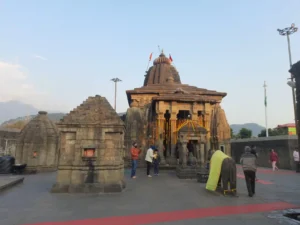
Shiv Mandir Baijnath and Pandavas
According to local tales, during their exile, the Pandavas visited the Shiva temple at Baijnath and worshipped Lord Shiva. Some believe that the Pandavas themselves may have commissioned the majestic temple. The story goes that they were tasked to build the temple in just one night, intending to bring the Ganges river to this sacred place.
However, someone deceived the Pandavas by falsely announcing the sunrise. With only the appearance of Ganga remaining, they had to abandon the task and move on. Had they completed their final endeavor, the Ganges would have flowed through Baijnath instead of Haridwar.
Even today, if one listens carefully in a corner of the temple, they might hear the sound of water. Legend says it is the hidden flow of the Ganges, still flowing beneath the temple’s foundations.

Ravana’s Foot in a Small Temple
The walkway from Baijnath to Paprola features a small temple located near the Binwa river, which is associated with Ravana. The temple contains a large footprint on a stone, believed to belong to Ravana. Additionally, some say that visiting this small temple of Ravana is essential to complete the Darshan of Lord Shiva.

Shiv Mandir Baijnath and Dussehra
Ravana, known for his unwavering devotion to Lord Shiva, was also dear to the deity. Because of this strong connection, Dussehra is never observed or celebrated in Baijnath. The reason is believed to be that Lord Shiva does not wish to witness his devoted follower, Ravana, being burnt in the city of Baijnath.
Several years ago, a businessman attempted to organize a Dussehra celebration in Baijnath, but his family faced significant hardships afterward. Since that incident, Dussehra has not been celebrated in Baijnath to this day, respecting Lord Shiva’s sentiments and connection to Ravana.
Shiv Mandir Baijnath and Jewellers
It’s surprising that despite being a sizable market, Baijnath lacks a jeweler’s shop. According to local stories, attempts were made in the past to establish a jeweler’s store, but unfortunate incidents occurred. One shop was mysteriously burnt down, leading to significant losses for the owner. Similarly, another businessman’s plans to open a jeweler’s shop were foiled, and he too suffered substantial losses.
The belief behind these incidents is linked to Ravana’s fondness for gold and Lord Shiva’s desire not to witness his devoted follower’s beloved metal business being set up in Baijnath. As a result, the city has not seen a successful jeweler’s shop, possibly due to these divine connections and mysterious occurrences.
People Also Read : Discover Dehnasar Lake: The Captivating Lake That Grants Your Desires
Shivratri in Shiva Temple Baijnath
The Shivratri fair in Baijnath honors Lord Shiva and draws thousands of devotees from the region. The ancient Baijnath Shiva Temple serves as the venue for this vibrant and religious celebration. The temple is adorned with colorful flowers and lights, creating a spiritual ambiance during this auspicious occasion. Throughout the day and night, pilgrims engage in prayers and traditional rituals. The fair offers cultural performances, local markets, and delectable traditional cuisine, providing a delightful experience for both devotees and tourists.

Makar Sakranti in Shiv Mandir Baijnath
The Shiv Temple in Baijnath hosts a special Ghrit Mandal festival during Makar Sankranti. The temple illuminates with colorful lights, and the priests melt ghee, shaping it into butter in cold water. This purified butter is then beautifully adorned over the Shivling. The festival extends for 7 days, attracting devotees from distant places who visit the temple during this period.
For centuries, this tradition has continued, using around 2 quintals of butter each year for decoration. The process involves mixing pure desi ghee in cold water, washing it 100 times to form butter, which is then placed over the Shivling for the 7-day celebration.
At the end of the festival, the butter is distributed among devotees. Although it is not consumed as prasad, it is believed to have medicinal properties for skin ailments, making it an effective remedy for skin diseases. According to belief, applying the ghee obtained from this prasad to the most stubborn skin diseases leads to their cure.

Kheerganga Ghat Near Shiva Temple
Kheerganga ghat lies on the bank of the river Binwa, just below the Shiva Temple. During the holy month of Shravan, people come here for a sacred bath, considering it highly auspicious. This place also serves as an alternative to Haridwar for those who cannot afford to travel there for the bone immersion ceremony after a person’s passing. According to belief, the water at Kheerganga ghat flows underground after touching the Shivling, adding to its significance.
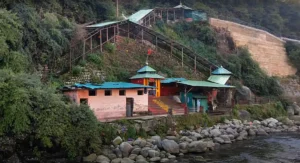
Location of Shiva Temple Baijnath
The Shiv Mandir Baijnath is situated in the town of Baijnath, in the Kangra District of Himachal Pradesh. Baijnath is a picturesque location, located 50 kilometers away from Kangra and 19 kilometers from Palampur. The town lies on the left bank of the Binwa River, and at the heart of Baijnath, near the bus stand, stands the majestic ancient temple of Lord Shiva. The temple’s magnificence is enhanced by the breathtaking view of the mighty Dhauladhars in the background.
Best time to visit Shiv Mandir Baijnath.
You can visit Shiv Mandir Baijnath in any season, but it offers a unique experience during winters when the Dhauladhar peaks are covered in snow. Visiting the temple during Mahashivratri is considered highly auspicious. Many people prefer to visit the temple during the Shravan month as it is believed to be Lord Shiva’s favorite month.
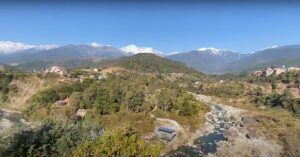
How to reach Shiv Mandir Baijnath ?
You can reach Shiv Mandir Baijnath either by road or train. Opting for the road route is the best choice as it is faster compared to the toy train running from Pathankot to Baijnath, which has a slow speed and takes more time. Direct buses are available from various cities like Delhi, Gurgaon, Chandigarh, Shimla, Pathankot, Jammu, Dehradun, and Haridwar to Baijnath. The distance from Delhi is approximately 600 km, and from Chandigarh, it is around 300 km.
Timings of Shiv Mandir Baijnath
Shiv Mandir Baijnath opens everyday from 4 am to 8 pm.
The aarti timings are as follows
5:15 AM Morning Aarti
12:15 PM Afternoon Aarti
7:30 PM Evening Aarti

Staying Options near Shiv Mandir Baijnath
Baijnath offers a variety of hotels and guest houses at reasonable prices for visitors. Some well-known options include Hotel Billing View, Temple Town, Kamakshi Guest House, Hotel Amit, and Hotel Binwa Palace. Additionally, in the nearby town of Bir, which is just 10 km away from Baijnath, one can find a wide range of accommodation options, from standard hotels to luxurious ones, and even camping facilities are available. There’s something for every traveler’s preference and budget in Baijnath and its vicinity.
Prominent temples near Shiv Mandir Baijnath
Baijnath is often referred to as Shiv Bhoomi due to its association with Lord Shiva a. The area around Shiv Mandir Baijnath is home to several significant temples. Here are a few of them:
Mahakal Temple
The Mahakal Temple, located approximately 6 kilometers from Baijnath, is a unique and revered Lord Shiva temple in Himachal. It holds significant importance and is considered on par with the Ujjain Mahakaleshwar temple. The temple is dedicated to Lord Shiva, making it a special and sacred destination for devotees in the region.
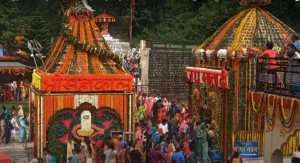
Mukutnath Temple Sansal
The temple, situated in the village of Sansal, about 6 kilometers away from Baijnath, holds great reverence among the locals. They firmly believe that worshipping Lord Shiva here bestows a high status upon the devotees.
Simsa Mata Temple
The Mata Simsa Temple, located approximately 25 kilometers from Shiv Mandir Baijnath towards Bhadol, is a place of intrigue and mystery. It holds a unique specialty as a “child giver” temple, and childless couples from all over India visit here to seek the blessings of Maa Durga for the gift of a child. Distance of Simsa Mata Temple from Pathankot is 150 kilometers.
Tourist places near Shiv Mandir Baijnath
Bir Billing
Bir Billing is a famous destination for paragliding enthusiasts and nature lovers. It offers breathtaking views of the Himalayas and is considered one of the best paragliding sites in the world. Billing, a nearby village, is the take-off point for paragliders.
Barot
Barot is a charming and secluded hill station nestled in the Dhauladhar range. It is renowned for its lush green landscapes, serene Uhl River, and mesmerizing trekking trails. The area is also famous for trout fishing, making it a popular destination for anglers. Barot’s tranquil ambiance and scenic beauty offer a perfect retreat for nature lovers and adventure enthusiasts alike.
Rajgundha
Rajgundha, is a picturesque and lesser-known valley blessed with breathtaking natural beauty. Surrounded by towering mountains and lush forests, it offers an idyllic escape for trekkers and nature enthusiasts. The valley is dotted with charming hamlets and offers stunning views of snow-capped peaks and glistening streams. Rajgundha’s serene ambiance and peaceful surroundings make it an ideal destination for those seeking tranquility in the lap of the Himalayas.
Palampur
Located approximately 15 kilometers from Baijnath, Palampur is a picturesque hill station known for its tea gardens, scenic landscapes, and pleasant weather. It’s a great place to unwind and enjoy the beauty of nature
Dharamshala
Situated around 50 kilometers from Baijnath, Dharamshala is a major town and the seat of the Tibetan government-in-exile. It offers a mix of Tibetan and Indian cultures, stunning monasteries, and beautiful views of the Dhauladhar mountain range.
Kangra Fort
About 50 kilometers from Baijnath, Kangra Fort is one of the largest forts in the Himalayas. It has a rich history and offers panoramic views of the surrounding valley
Andretta
Located around 13 kilometers from Baijnath, Andretta is an artist’s village known for its pottery and art galleries. It’s a serene place with a bohemian vibe, attracting artists and creative individuals.
Chamunda Devi Temple
Situated about 30 kilometers from Baijnath, this temple is dedicated to Goddess Chamunda, a form of Durga. The temple is situated amidst scenic surroundings and holds religious significance.
In conclusion, the Shiv Mandir in Baijnath stands as a revered and sacred place, attracting devotees from far and wide. With its rich association with Lord Shiva and the intriguing temple of Ravana nearby, it holds a unique spiritual significance. Its peaceful and serene ambiance, coupled with the belief in the sanctity of the temple, makes it a cherished destination for seekers of divine blessings and a profound connection with the divine.
Next time you find yourself near Baijnath, Bir Billing, Dharamshala, Palampur, or Kangra, We highly recommend considering a visit to this ancient Shiv Mandir. Its historical significance, coupled with the nearby temple associated with Ravana, makes it a unique and spiritually enriching experience. Don’t miss the chance to explore this sacred destination and connect with its serene ambiance and divine blessings.
People Also Read : How to make Siddu ? Aunhtentic Himachali Siddu Recipe
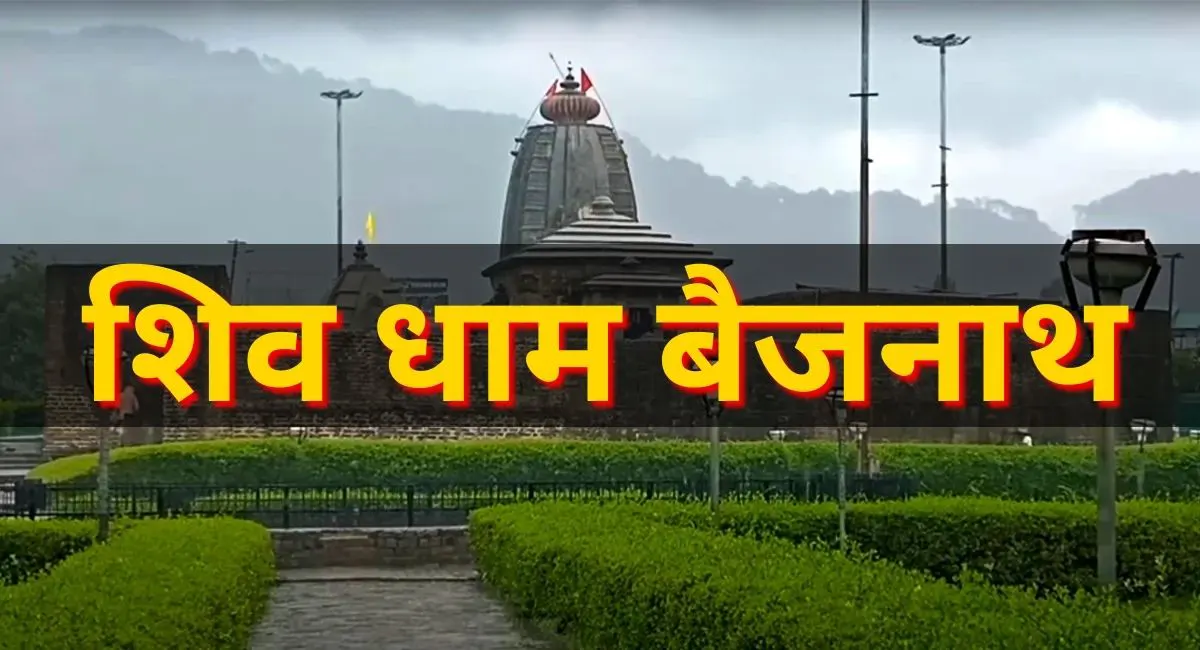
Wow nice information